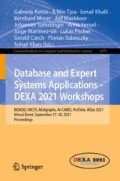Abstract
This study presents our ongoing research on designing new methods for changepoint detection in industrial environments using a CUSUM method variant. The changepoint detection refers to identifying the location of change of some aspect in a given time series. The significant difference concerning a state-of-the-art time series prediction technique (using an LSTM) is that our method can handle anomalies masked by non-trivial trends. We have evaluated our proposal with a systematic series of test data and an example set with wear-induced anomalies.
Access this chapter
Tax calculation will be finalised at checkout
Purchases are for personal use only
References
Aminikhanghahi, S., Cook, D.J.: A survey of methods for time series change point detection. Knowl. Inf. Syst. 51(2), 339–367 (2016). https://doi.org/10.1007/s10115-016-0987-z
Athanasopoulos, R.J., George, H.: Forecasting: Principles and Practice. 2nd edn. (2018)
Barnard, G.A.: Control charts and stochastic processes. J. R. Stat. Soc. Ser. B (Methodol.) 21(2), 239–257 (1959)
Basseville, M., Nikiforov, I.V., et al.: Detection of Abrupt Changes: Theory and Application, vol. 104. Prentice Hall Englewood Cliffs, Englewood Cliffs (1993)
Benveniste, A.: On-line detection of jumps in mean. Lect. Notes Control Inf. Sci. 77, 567 (1984)
Brown, R.L., Durbin, J., Evans, J.M.: Techniques for testing the constancy of regression relationships over time. J. R. Stat. Soc. Ser. B (Methodol.) 37(2), 149–163 (1975)
Graves, S., et al.: A new approximation for the average run length of a cusum. In: Joint Statistical Meeting, Indianapolis (2000)
Hawkins, D.M., Olwell, D.H.: Statistics for engineering and physical science-cumulative sum charts and charting for quality improvement (1998)
Hinkley, D.V.: Inference about the change-point in a sequence of random variables (1970)
Hochreiter, S., Schmidhuber, J.: Long short-term memory. Neural Comput. 9(8), 1735–1780 (1997)
Killick, R., Fearnhead, P., Eckley, I.A.: Optimal detection of changepoints with a linear computational cost. J. Am. Stat. Assoc. 107(500), 1590–1598 (2012)
Mahmoud, S., Sobieczky, F., Martinez-Gil, J., Praher, P., Freudenthaler, B.: Decay-parameter diagnosis in industrial domains by robustness through isotonic regression. Procedia Comput. Sci. 180, 466–475 (2021)
Page, E.S.: Continuous inspection schemes. Biometrika 41(1/2), 100–115 (1954)
Pettitt, A.N.: A non-parametric approach to the change-point problem. J. R. Stat. Soc. Ser. C (Appl. Stat.) 28(2), 126–135 (1979)
Sharma, S., Swayne, D.A., Obimbo, C.: Trend analysis and change point techniques: a survey. Energy Ecol. Environ. 1(3), 123–130 (2016)
Tartakovsky, A., Nikiforov, I., Basseville, M.: Sequential Analysis: Hypothesis Testing and Changepoint Detection, 1st edn. Chapman Hall/CRC, Boca Raton (2014)
Wald, A.: Sequential Analysis, 1st edn. John Wiley and Sons, New York (1947)
Zeileis, A., Leisch, F., Hornik, K., Kleiber, C.: strucchange: an r package for testing for structural change in linear regression models. J. Stat. Softw. Articles 7(2), 1–38 (2002)
Acknowledgements
We thank the anonymous reviewers for theil helpful comments to improve the manuscript. This work has been supported by the project AutoDetect (Project No. 862019; Innovative Upper Austria 2020 (call Digitalization)) as well as the Austrian Ministry for Transport, Innovation and Technology, the Federal Ministry of Science, Research and Economy, and the Province of Upper Austria in the frame of the COMET center SCCH.
Author information
Authors and Affiliations
Corresponding author
Editor information
Editors and Affiliations
Rights and permissions
Copyright information
© 2021 Springer Nature Switzerland AG
About this paper
Cite this paper
Mahmoud, S., Martinez-Gil, J., Praher, P., Freudenthaler, B., Girkinger, A. (2021). Deep Learning Rule for Efficient Changepoint Detection in the Presence of Non-Linear Trends. In: Kotsis, G., et al. Database and Expert Systems Applications - DEXA 2021 Workshops. DEXA 2021. Communications in Computer and Information Science, vol 1479. Springer, Cham. https://doi.org/10.1007/978-3-030-87101-7_18
Download citation
DOI: https://doi.org/10.1007/978-3-030-87101-7_18
Published:
Publisher Name: Springer, Cham
Print ISBN: 978-3-030-87100-0
Online ISBN: 978-3-030-87101-7
eBook Packages: Computer ScienceComputer Science (R0)

